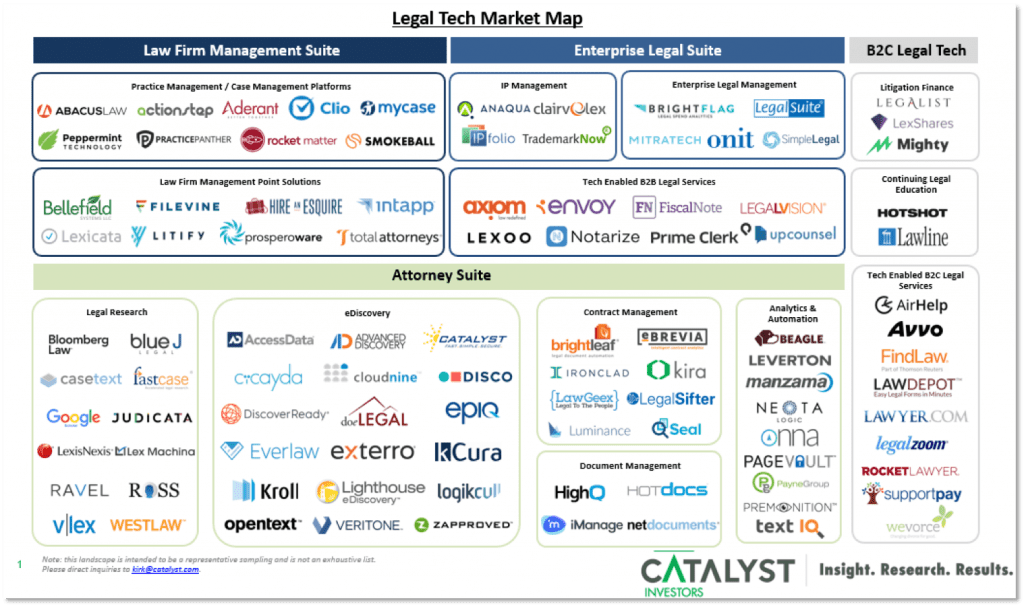Legal Workflow Automation: One Solution to Unite Them All?
Legal technology adoption for an in-house legal department or a law firm is a big enough challenge. Getting both of them to see eye-to-eye on what platforms and solutions to use? That’s a bigger headache.
To start with, it’s an amazingly crowded market. The chart below shows only a fraction of the providers competing for different slices of the legal tech market. Stanford’s online listing of legal tech startups and other firms includes over 1,100 companies, and that’ll grow as more investor money races into the category. So making legal tech adoption decisions can be tough sledding for anyone, and that’s before figuring in the need for integration with another party.
What may be an even more pressing challenge for the players mentioned above – in-house legal teams and outside counsel – is how to make legal tech adoption decisions that don’t just serve their own respective needs, but “play nice” with each other. That’s the gist of a recent article at Corporate Counsel.
Both sides want greater collaboration and efficiency, but they’ve each got to make sure their technology choices serve their own demands first. Yet having synchronous solutions solves multiple problems.
As a law firm legal project manager explains in the article, his firm is “trying to get our attorneys to do a better job of managing their cases using [the firm’s] own case management system. So what happens in many cases is you have lawyer staff who are required to update two systems.”
A cornerstone of transformation and collaboration
Is there really any single technology capable of uniting a company’s legal ecosystem, binding every constituent together and overcoming a patchwork of existing systems and agendas? A kinder, gentler legal tech equivalent of Sauron’s ring?
 We’re going to laud legal workflow automation as the clear winner here. Why? Because its effectiveness at the task we’ve just described has been proven in practice across multiple implementations of our own offering, TAP.
We’re going to laud legal workflow automation as the clear winner here. Why? Because its effectiveness at the task we’ve just described has been proven in practice across multiple implementations of our own offering, TAP.
A legal workflow automation solution that’s built on a platform- and device-agnostic SaaS architecture enjoys smooth API and connector-based integration with everything. That ranges from full-blown enterprise legal management systems to other tools, like a user’s existing timekeeping and e-billing software.
As one experienced Legal Ops workflow automation pioneer, Connie Brenton of NetApp, points out, this supplies a solution that’s “one of the few that can be used across the entire legal ecosystem, especially between the in-house legal teams and the law firms that help enable them.”
Scoring benefits for everybody in the ecosystem
So it makes sense to implement workflow automation first (though the best solutions can be added to an existing legal tech stack with virtually no disruption). Then corporate Legal Operations teams, law firm CIOs, attorneys, GCs and practically everyone else who touches legal processes can tick off the benefits:
- Solid integration across the legal ecosystem that lets both sides work better together.
- Improved visibility into in-house/outside processes for the client.
- Accelerated responsiveness and efficiency for the law firm.
- Adoption of a cornerstone technology that paves the way for the downstream arrival of other solutions.
- Immediate ROI that helps justify future legal tech investment.
The Corporate Counsel article signs off by asking this about legal tech integration: “The only question is, will 2019 be the year it all comes together?”
Our answer? It will – if a truly foundational solution like legal workflow automation is put in place first.
“One of the few (solutions) that can be used across the entire legal ecosystem, especially between the in-house legal teams and the law firms that help enable them.”
Connie Brenton
Chief of Staff/Senior Director of Legal Operations, NetApp




